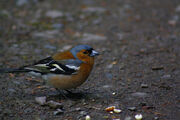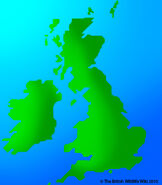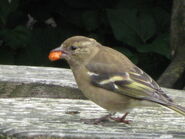
Chaffinch - http://www.flickr.com/photos/gordiesbirdies
The Chaffinch (Fringilla coelebs), also called by a wide variety of other names, is a small passerine bird.
Description[]
The Chaffinch's large double white wing bars, white tail edges and greenish rump easily identify this 14–16 cm long species. The breeding male is unmistakable, with his reddish underparts and a blue-grey cap. The female is drabber and greener, but still obvious.
Behaviour[]
This bird is not migratory in the milder parts of its range, but vacates the colder regions in winter. The coelebs part of its name means "bachelor". This species was named by Linnaeus; in his home country of Sweden, where the females depart in winter, but the males often remain. This species forms loose flocks outside the breeding season, sometimes mixed with Bramblings. This bird occasionally strays to eastern North America, although some sightings may be escapees.
It builds its nest in a tree fork, and decorates the exterior with moss or lichen to make it less conspicuous. It lays about six eggs, which are greenish-blue with purple speckling.

The Chaffinch
NATURE The Chaffinch by Richard Claxton - http://www.youtube.com/user/richardclaxtoncni
The main food of the chaffinch is seeds, but unlike most finches, the young are fed extensively on insects, and adults also eat insects in the breeding season.
The powerful song is very well known, and its fink or vink sounding call gives the finch family its English name. Males typically sing two or three different song types, and there are regional dialects too.
The acquisition by the young chaffinch of its song was the subject of an influential study by British ethologist William Thorpe. Thorpe determined that if the chaffinch is not exposed to the adult male's song during a certain critical period after hatching, it will never properly learn the song. He also found that in adult chaffinches, castration eliminates song, but injection of testosterone induces such birds to sing even in November, when they are normally silent.




